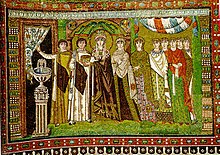Saint Anastasia the Patrician | |
|---|---|
| Born | 6th Century |
| Died | 6th Century |
| Venerated in |
Catholic Church Oriental Orthodoxy Eastern Orthodox Church |
| Feast | 10 March 26 Tobi ( Coptic Christianity) [1] |

Saint Anastasia the Patrician ( Latin: Anastasia Patricia, Greek: Άναστασία Πατρικία, romanized: Anastasía Patrikía; fl. 576) was a Byzantine courtier and later saint. [2] She was a lady-in-waiting to the Byzantine empress Theodora. [3] Justinian I, Theodora's husband, may have pursued her, as Theodora grew jealous of her. [2] Anastasia, to avoid any trouble, left for Alexandria in Egypt. [2] She arrived at a place called Pempton, near Alexandria, where she founded a monastery which would later be named after her. She lived with monastic discipline and wove cloth to support herself. [2]
Following the death of Theodora in 548, Justinian attempted to get Anastasia to return to Constantinople, to no avail. [2] Instead, Anastasia left for Scetis, looking for help from Abba Daniel, hegumen of the monastery at that time. [4] [2] To safeguard Anastasia, he let her move into a laura or monastery cell 18 miles from Scetis in the desert, and dress as a (male) monk [2] and take up the life of a hermit at a time when this was only permitted to men. He visited her every week and ensured that one of his disciples supplied her with jugs of water. [2] Anastasia dwelt in seclusion for twenty-eight years. [2]
In 576, [5] aware of her approaching death, she wrote several words for Abba Daniel on a piece of broken pottery and placed it at the entrance to the cave. The disciple found an ostracon with the words "Bring the spades and come here." When Daniel heard this, he knew Anastasia was near death. [2] He went to visit her with his disciple and to give her communion and hear her last words. [4] [2] Daniel revealed the full details of her story to his disciple after her death.
Her story survives in one recension of the Copto-Arabic Synaxarion and by a tale of Daniel of Scetis. Her feast day is 10 March [2] in the Eastern Orthodox Church, the Catholic Church, and on 26 Tobi in the calendar of the Coptic Church, [1] the date of her death given in the Ethiopic Life of Daniel of Scetis. [6] She has been adopted by today's LGBT community as an example of a " transgender" saint. [7] [8]
References
- ^ a b Coptic Orthodox Church Network. 'Commemorations For Toba 26,' Lives Of The Saints. Accessed 28 Jan 2021.
- ^ a b c d e f g h i j k l Laura Swan, The Forgotten Desert Mothers (2001, ISBN 0809140160), pages 72-73
- ^ Anne Commire, Deborah Klezmer. Women in World History: A Biographical Encyclopedia (1999, ISBN 0787640808), page 274.
- ^ a b "St. Anastasia the Patrician of Alexandria", Antiochian Orthodox Christian Archdiocese
- ^ Coquin, Rene Georges. "Anastasia, Saint", The Coptic Encyclopedia, Vol. I, MacMillan (1991)
- ^ Vivian, Tim. Witness to Holiness: Abba Daniel of Scetis. Cistercian Publications, 2008.
- ^ Conner, Randy P.; Sparks, David Hatfield; Sparks, Mariya; Anzaldúa, Gloria (1997), Cassell's Encyclopedia of Queer Myth, Symbol, and Spirit: Gay, Lesbian, Bisexual, and Transgender Lore, Cassell, p. 57, ISBN 0-304-33760-9
- ^ Dale Albert Johnson, Corpus Syriacum Johnsoni I (2015, ISBN 1312855347), page 348
External links
- Atiya, Aziz S. The Coptic Encyclopedia. New York: Macmillan Publishing, 1991. ISBN 0-02-897025-X
- Coquin, Rene Georges. "Anastasia, Saint", The Coptic Encyclopedia, Vol. I, MacMillan (1991)